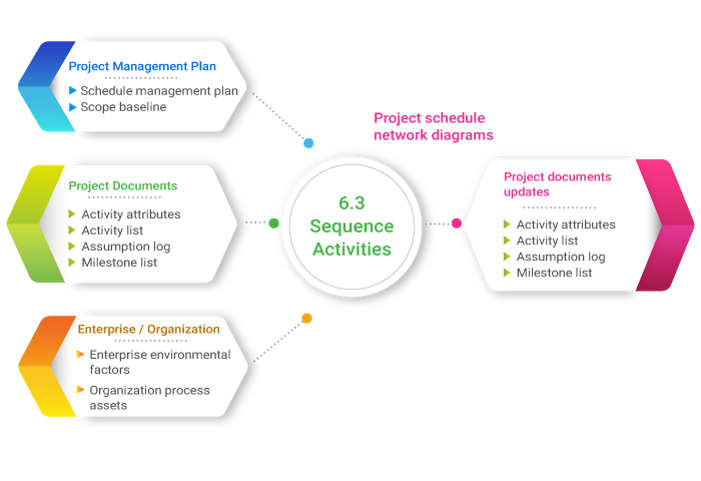
A project manager is liable for the complete development of the project. By incorporating planning and aligning the objectives of the project, the process functions smoothly. Consequently, the reason for a project failure is when the project managers can create the work analysis structure, yet can’t execute it. As project managers, it is necessary to consider a plan for your project that includes all the Project Management skills, knowledge, and tools & techniques. This article discusses the sequence activities in a project and its process, the importance of sequence activities, and the necessity to determine activity sequencing on projects.
Defining the Sequence Activities
The strategy of distinguishing and authenticating affiliates amidst the project activities, and sequence activities illustrates the consistent planning of work to get the highest effectiveness of the project constraints. Throughout the project, the process of the execution plan is for better performance.
The sequence activities are designed to fall under Project Management process groups and knowledge areas. By using the results from the procedures, the project schedule development defines sequence activities, estimates activity resources, and estimates activity durations in combination with the scheduling tool to produce the schedule model. The schedule management plan recognizes what scheduling method and device to use for the task, which will manage the activities to be sequenced.
How to Sequence Activities in a Project?
Sequencing can be performed by utilizing Project Management software or by using manual or mechanized procedures. The sequence activities process concentrates on converting the project activities from a list to a diagram to act as a first step to publishing the schedule baseline.
The below chart portrays the data flow diagram of sequence activities on how every activity except the first and last should connect to at least one predecessor and at least one successor activity with an appropriate logical affiliation.
Process of Sequence Activities in Project Management
Sequence activities are the process of identifying and documenting relationships among the project activities. So the fundamental reason for the sequence activities process is finalizing the interrelationship of activities to finish the project scope and achieve the task objectives.
The critical consequence of the sequence activities process is a Network Diagram. The network diagram of a project represents the activities in boxes with activity ID and demonstrates the interrelationship of activities with bolts.
Each activity excluding the first and last ought to be associated with at least one predecessor and at least one successor activity with a proper logical relationship. A realistic project schedule ought to be apt by creating logical relationships. It might be essential to utilize lead or lag time between exercises to help a sensible and reachable undertaking plan. Sequencing can be performed by using software that is built for Project Management, manual or computerized procedures. The sequence activities process focuses on changing the project activities from a list to a diagram to go about as an initial step to distribute the schedule baseline.
Network Diagram Example for Sequence Activities Process
- Process of identifying and documenting relationships among the project activities
- Key results of this process are Network Diagram
- If activity durations are added, the network diagram shows the critical path
This figure shows a sample network diagram as a result of the sequence activities process.
As you see, after the start of the project,
- Activity #1 must start first.
- After Activity #1 finishes, Activity #2 and Activity #3 will begin.
- Activity #4 can start only after Activity #2 finishes.
- Activity #5 depends on Activity #2 and Activity #3. Therefore, it will start only after these two activities are completed.
- And the last Activity, activity #6 can start only if Activity #4 and Activity #5 is completed.
- After activity #6 completion, the project will end.
Note that this is just a simple and sample network diagram to show you how a network diagram is. In real-life projects, there will be lots of project activities, so the network diagram and also sequence activities process will be much more complicated than this.

Tools Used in Project Management Sequence Process
In the process of sequencing activities in Project Management, the project manager identifies and records relationships among the various project activities so that he/she can define the best logical sequence that can produce the highest efficiency. In the end, the project manager can develop a Project Management sequence process.
There are three tools and techniques used in the Project Management sequence process:
- Precedence Diagramming Method (PDM)
- Dependency Determination
- Leads and Lags
Why is it Important to Determine Activity Sequencing on Projects?
It is important to focus on planning and determining activity sequencing on projects. Otherwise, you will find yourself exhausting your resources in the initial activities only to find out bigger and more crucial activities making them obsolete without a concrete plan.
You cannot determine the hard way for a project unless you sequence activities. Several different diagrams are the same to project network diagrams. In transportation modeling, for example, you try to find the shortest way between two points. As clearly seen in the diagrams, you only need to take one path. In a project network diagram, all activities must be completed to complete the project.
Precedence Diagramming Method
The Precedence Diagramming Method is a technique that is utilized to develop a schedule model where activities are signified by nodes that are connected to one or more affiliates to its successors by a projectile.
Precedence Diagramming Method incorporates four kinds of dependencies or logical predecessor-successor relationships:
- Finish-to-Start: Until the predecessor activity is complete, the successor activity cannot start.
- Finish-to-Finish: The successor activity can’t be completed until the point that a predecessor activity is complete.
- Start-to-Start: Unless the predecessor activity has not started a successor activity cannot start.
- Start-to-Finish: Until the predecessor activity has not begun, a successor activity cannot finish.
Once the derivation of the connections among the activities of the projects is done, you will receive a sequence that sets up activities interlinked with each other given their affiliation. This setup is known as the network diagram of the project.
The Necessity to Determine Activity Sequencing on Projects
You can’t decide the most challenging way possible for a project unless you sequence activities. Numerous illustrations are similar to the project network diagrams, and hence you strive to track down the most accessible route between two points. You need to take only one point from the illustrations. In a project network diagram, you need to complete all the activities in the project.
Leads and Lags in Sequence Activities
Leads and Lags are essential tools for Sequencing Project Activities.
- Successor activity is allowed to start early, and it is pertinent to Finish-to-Start type support, which is the most basic connection between activities. A Lead enables successor activity to begin soon.
- Lag, relevant to Start-to-Start, a sort of dependency connection between exercises, makes successor action postpone its beginning. For example, if you choose to delay the procurement of building materials by three days after the designs of the plan begin. It would appear to start with three days of slack time.
Conclusion
In the end, when you end with sequencing the project activities, you discover some changes to the inputs used – that is, an activity list and activity attributes. There are chances to identify specific risks. So as a project manager, you will update the project documents and other outputs. To gain more insights and the best skills to overcome challenging problems, enroll in the PMP Online Certification program and take your project management journey to newer heights.
Know more about Project Management best practices through Invensis Learning’s Project Management certification training on PMP Training Programs, CAPM Certification Classes, Prince2 Foundation and Practitioner Certification, Project Management Fundamentals, etc.




















